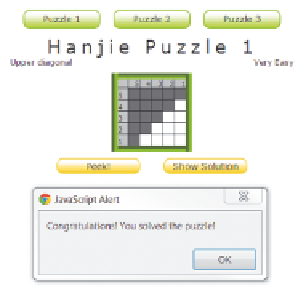HTML and CSS Reference
In-Depth Information
Figure 13-36
successfully completed puzzle
◗
5.
Click the
OK
button to close the dialog box.
Problem Solving: Principles of Puzzle Design
Puzzles are among the oldest forms of entertainment, starting with the mazes and laby-
rinths created almost 4000 years ago and leading to the popular
Sudoku
and interactive
puzzles of the present day. Puzzle games are a huge part of the game market. For example,
the popular puzzle game
Angry Birds
topped a half-billion downloads within a year of its
release, with gamers worldwide spending about 300 million minutes each day playing it.
Puzzles can be placed within the following general categories:
•
mathematics and logic (
Sudoku
,
Minesweeper
,
Rubik's Cube
)
•
physics (
Angry Birds
,
Cut the Rope
)
•
visual (
Where's Waldo?
, hidden objects)
•
language (crosswords, anagrams, word search)
•
situational (riddles, adventure games,
Twenty Questions
)
Regardless of its category, a successful puzzle needs well-defined rules with a clear over-
all objective. One great challenge in puzzle design is to find the balance between making a
puzzle too easy, which can be boring, and too hard, which users might find frustrating. No
one reads tutorials, so beginning puzzle levels should act as a training ground for success
at higher levels. To keep gamers motivated, many designers stagger the difficulty levels
so that after a particularly difficult level, an easier level follows—giving players a “mental
breather” before moving on to new challenges.
Play testing is a key component in puzzle development. Testing should be done
•
early in the development process and continuously as the puzzle is changed and modified
•
on people who have not played the game before
•
without providing users with extraneous hints or information
After each test, the user should be interviewed to learn which features of the game were
successful, and which need more work and development. Compile statistics on the amount
of time needed to complete each step. You might find that you need to add more train-
ing levels, or that your puzzle has unnecessary distractions or false clues. Finally, don't be
afraid to remove a level from your design if it is stalling the user's progress through the
game. Remember that the most successful puzzle game is one that teaches users how to
solve it by playing it.








